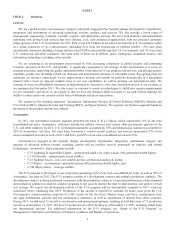Lockheed Martin 2013 Annual Report Download - page 20
Download and view the complete annual report
Please find page 20 of the 2013 Lockheed Martin annual report below. You can navigate through the pages in the report by either clicking on the pages listed below, or by using the keyword search tool below to find specific information within the annual report.In addition, certain of our U.S. Government contracts span one or more base years and multiple option years. The U.S.
Government generally has the right not to exercise option periods and may not exercise an option period for various reasons.
However, the U.S. Government may exercise option periods, even for contracts for which it is expected that our costs may
exceed the contract price or ceiling.
U.S. Government agencies, including the Defense Contract Audit Agency, the Defense Contract Management Agency,
and various agency Inspectors General, routinely audit and investigate government contractors. These agencies review a
contractor’s performance under its contracts, its cost structure, its business systems, and compliance with applicable laws,
regulations, and standards. Any costs found to be misclassified may be subject to repayment. We have unaudited and/or
unsettled incurred cost claims related to past years, which places risk on our ability to issue final billings on contracts for
which authorized and appropriated funds may be expiring.
Certain deficiencies identified during government audits of contractor business systems may result in the government
withholding payments on our billings. Such deficiencies have not impacted our internal control over financial reporting.
Withholding payments on billings are capped at 5% of billings when deficiencies impact a single business system and 10%
when deficiencies impact multiple systems. Such withholdings are typically reduced to 2% after the contractor’s corrective
action plan has been accepted and progress to implement the corrective actions has been demonstrated, and are withdrawn
upon satisfactory completion and verification of the corrective action plan.
If an audit or investigation uncovers improper or illegal activities, we may be subject to civil or criminal penalties and
administrative sanctions, including reductions of the value of contracts, contract modifications or terminations, forfeiture of
profits, suspension of payments, penalties, fines, and suspension or prohibition from doing business with the U.S.
Government. In addition, we could suffer serious reputational harm if allegations of impropriety were made against us.
Similar government oversight exists in most other countries where we conduct business.
Our profitability and cash flow may vary based on the mix of our contracts and programs, our performance, our
ability to control costs, and evolving U.S. Government procurement policies.
Our profitability and cash flow may vary materially depending on the types of long-term government contracts
undertaken, the nature of the products produced or services performed under those contracts, the costs incurred in performing
the work, the achievement of other performance objectives, and the stage of performance at which the right to receive fees is
determined, particularly under award and incentive-fee contracts.
Our backlog includes a variety of contract types which are intended to address changing risk and reward profiles as a
program matures. Contract types include cost-reimbursable, fixed-price incentive-fee, fixed-price, and time-and-materials
contracts. Contracts for development programs with complex design and technical challenges are typically cost-reimbursable.
Under cost-reimbursable contracts, we are reimbursed for allowable costs and paid a fee, which may be fixed or
performance-based. In these cases, the associated financial risks primarily relate to a reduction in fees, and the program could
be cancelled if cost, schedule, or technical performance issues arise.
Other contracts in backlog are for the transition from development to production (e.g., low-rate initial production (LRIP)
contracts), which includes the challenge of starting and stabilizing a manufacturing production and test line while the final
design is being validated. These generally are cost-reimbursable or fixed-price incentive-fee contracts. Under a fixed-price
incentive-fee contract, the allowable costs incurred are eligible for reimbursement, but are subject to a cost-share
arrangement, which affects profitability. Generally, if our costs exceed the contract target cost or are not allowable under the
applicable regulations, we may not be able to obtain reimbursement for all costs and may have our fees reduced or
eliminated.
There are also contracts for production as well as operations and maintenance of the delivered products that have the
challenge of achieving a stable production and delivery rate, while maintaining operability of the product after delivery.
These contracts are mainly fixed-price, although some operations and maintenance contracts are time-and-materials type.
Under fixed-price contracts, we receive a fixed price regardless of the actual costs we incur. We have to absorb any costs in
excess of the fixed price. Under time-and-materials contracts, we are paid for labor at negotiated hourly billing rates and for
certain expenses.
The failure to perform to customer expectations and contract requirements may result in reduced fees or losses and affect
our financial performance in that period. Under each type of contract, if we are unable to control costs, our operating results
could be adversely affected, particularly if we are unable to justify an increase in contract value to our customers. Cost
overruns or the failure to perform on existing programs also may adversely affect our ability to retain existing programs and
win future contract awards.
12
























